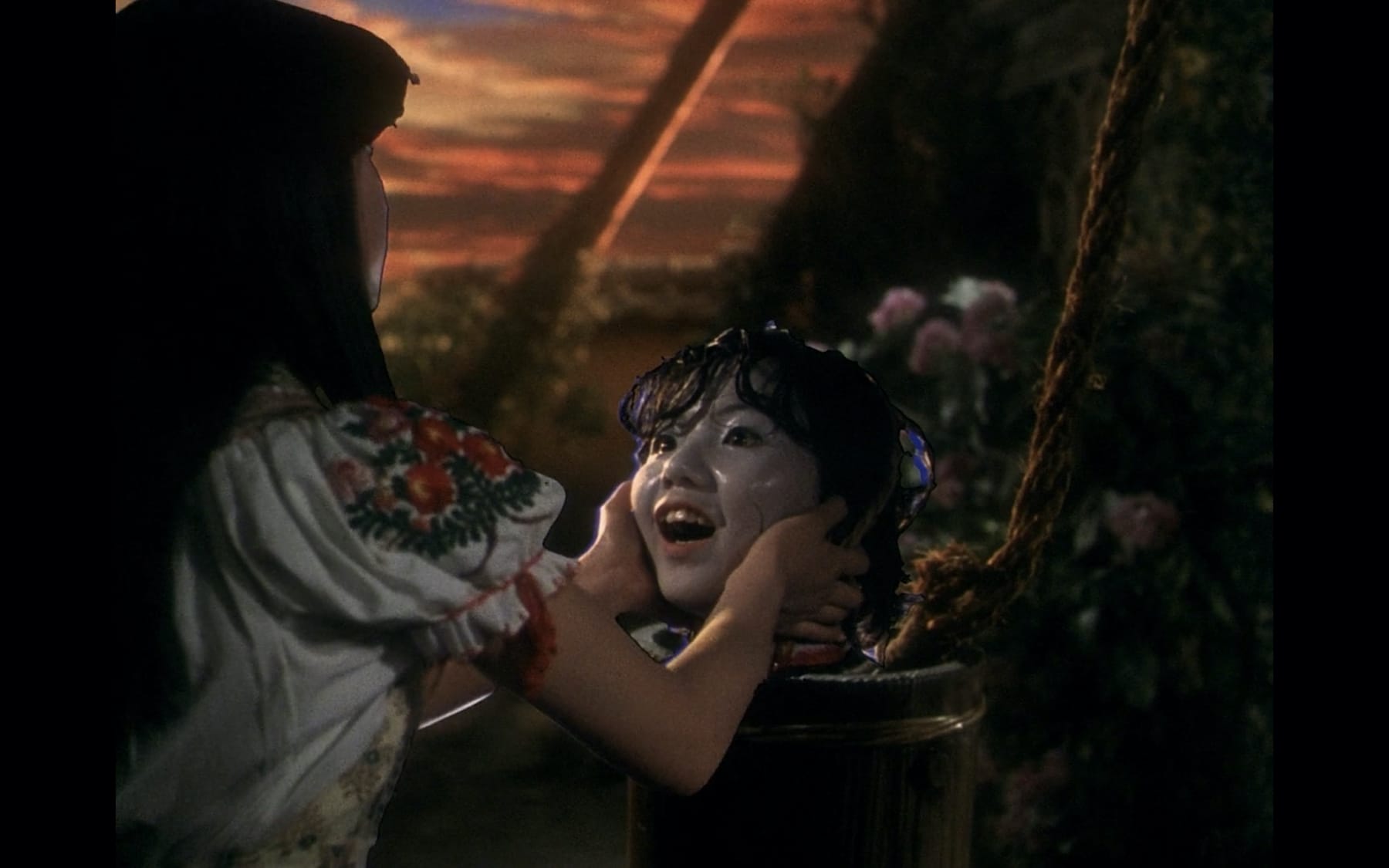Best friends, Gorgeous and Fantasy, are playing with a camera between classes. Staging photos and posing for one another. Gorgeous looks serious wrapped in white, like a bride on her wedding day. Fantasy is about to snap the photo but looks up from the camera to stare. She is wide eyed and almost spooked as if sensing danger.
The sullen bride urges her to hurry and take the photo. Later when asked why she was looking at Gorgeous like that, Fantasy only laughs. Teasing that she looked just like a witch in a horror movie. Gorgeous jokes back that Fantasy’s imagination is getting away from her again. Always seeing things that aren’t really there.
In the late 70’s, Toho Studios wanted to make a summer blockbuster as successful as Jaws. Established in experimental film, Nobuhiko Obayashi pitched a coming-of-age horror story. Inspired by fear from the point of view of children. The director loved how a child’s mind could create the unexplainable from nothing. Nobuhiko Obayashi’s Hausu (or House) would feel like a kid’s nightmare. The director drew from his own childhood traumas as a Hiroshima survivor.
Obayashi also consulted his pre-teen daughter when writing Hausu’s screenplay. The 11-year-old confessed fears of being smothered by blankets and bedding. Wary of the grand piano during her lessons, afraid the massive thing would eat her fingers off. Also fearing her own reflection moving independently or attacking her.
These true-life terrors would be the foundation of Obayashi’s psychedelic masterpiece.
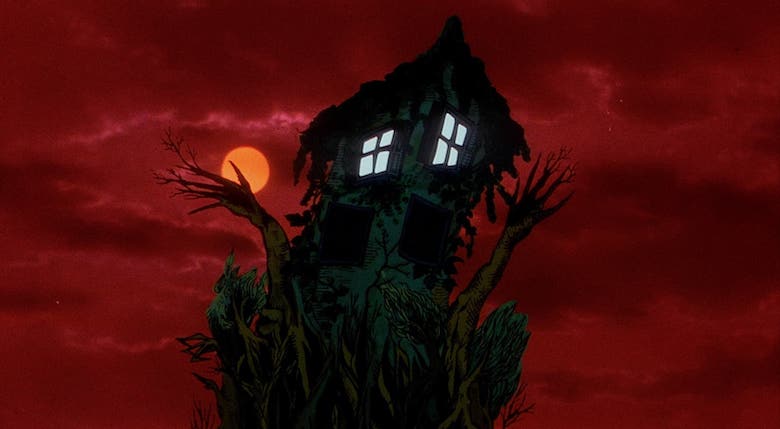
Hausu is the story of Gorgeous, a beauty obsessed teen. Spitting image of her late mother, she fills the void in her father’s life. Caring for him by cooking, cleaning, and mending clothing. Gorgeous is devastated to learn that her father is planning to remarry. Afraid he’s replacing her and letting go of her mother’s memory. She writes to her Auntie, asking to spend the summer at her house in the countryside. Inviting her friends to tag along, each bearing a character trope nickname. Memories of Gorgeous’ Auntie play as a film within a film. Older sister to her late mother, she was once engaged to be married. But her fiancé was drafted to war and vowed to return. The war ends and peace declared but Auntie continues to wait for her true love. Even now as an elderly piano teacher in a wheelchair. She waits in the shadows with her ghostly white cat, Blanche.
“Your Auntie is waiting for you.”
The teenagers are welcomed into the titular house. Inside is dark with high ceilings and long halls. Likenesses of Auntie’s pet decorate her entire home. Figurines, carvings, and several creepy paintings of Blanche. Almost suggesting a Portrait of Dorian Grey theme. Haunted houses and evil cats are standard tropes in Japanese horror. The classic films, Black Cat Mansion and Ghost-Cat of Gojusan-Tsugi utilized folk legends of bakeneko (ghost cats). Apparitions of revenge and unsettled souls, like Mar from the Ju-On franchise. Or the “Cat From Hell” short in the Tales From The Darkside The Movie anthology. Blanche may very well be a bakeneko, appearing and disappearing throughout Hausu. A witchy familiar with glowing eyes and long hair as white as Auntie’s.
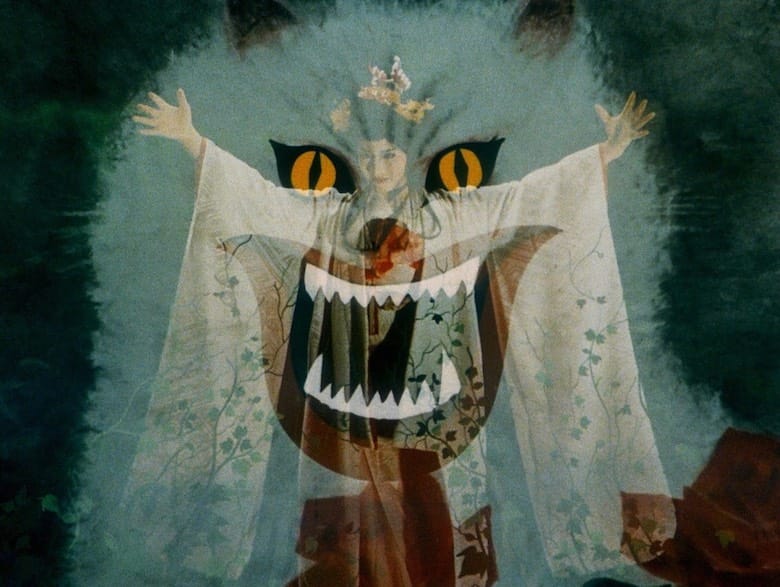
The old woman admits talking to her furniture and appliances, living all alone. Demonstrating by informing the oven that the glutenous Mac will warm it again with food. Or perhaps as food, considering she is the first to vanish. Fantasy goes to look for Mac instead finding a human head in the well. When the other girls investigate, they only find a watermelon. Dismissing Fantasy’s claims due to her infamously wild imagination. Auntie comes to life after Mac’s disappearance. Mincing about and telling the young girls they give her energy. Breaking the 4th wall, we see Auntie eating human body parts. Also nibbling a fat goldfish from a bowl with six more swimming in panicked circles. Gleefully dancing with Blanche through the rest of Nobuhiko Obayashi’s Hausu as the girls drop off.
— FOUNDATIONS OF HORROR —
Further explore these subgenres & tropes. more>>
#Children’s horror | #My House is Scary | #Animals are Scary
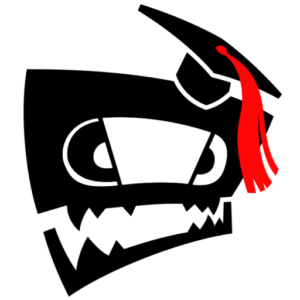
Gorgeous is occupied with dressing for the occasion using Auntie’s vanity. In the mirror, she is transfixed with her own reflection. Images distort to visions of her Aunt and Mother in simpler times. Staring deep into the glass she is lost in their pain from the war. The loss of Auntie’s fiancé and sisters separating by marriage and time. The mirror shatters as does Gorgeous’ face, pieces falling away. Revealing a raging fire within that consumes her entirely.
Examining Nobuhiko Obayashi’s Hausu
While considered part horror and part comedy, Nobuhiko Obayashi’s Hausu is the liminal space between child and adult. The director doesn’t just create the fantastical horrors of a child’s mind. He subtly presents the real traumas of a kid’s emotional life. The indistinction between growing up too fast or being a late bloomer. Your mind playing tricks on you and feeling helpless when others refuse to listen.
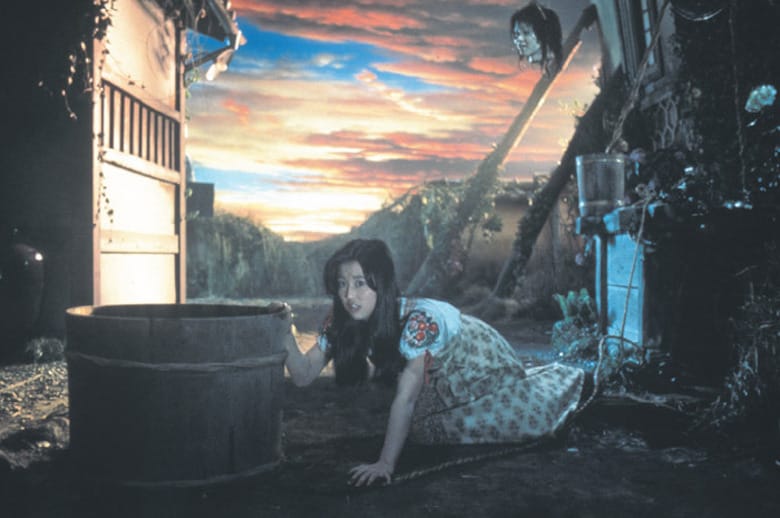
The rivalry among siblings appears between Gorgeous’ Mother and Auntie. Fears of being replaced in the family. The lifelong resentment of living up to a parent’s expectations.
Lastly, it should be noted that our relationships with death begins as children. Unequipped with tools to process grief can result in becoming enveloped in it. Just as Gorgeous and Auntie are consumed by time’s bitter flames. Nobuhiko Obayashi’s Hausu is a campy joyride. While still sheltering the many painful crosses that every young person will one day bear.
Last Updated on June 13, 2021.

